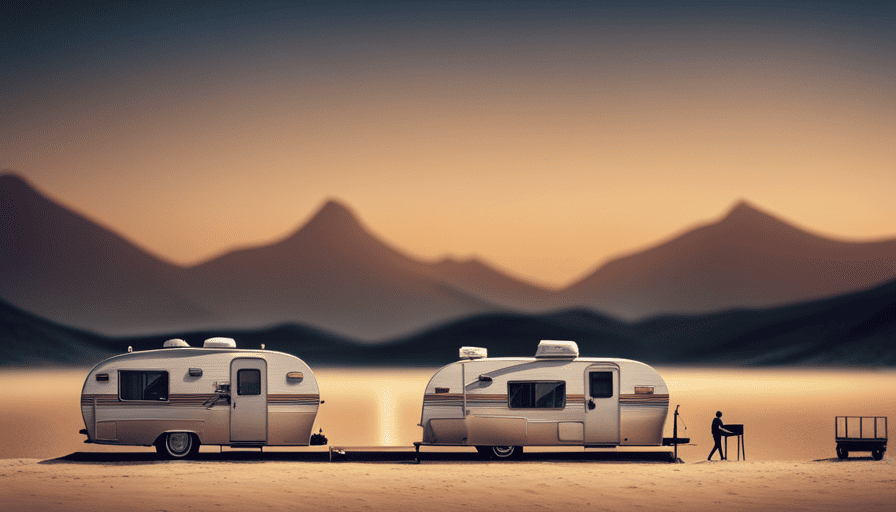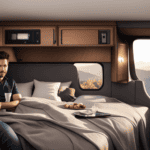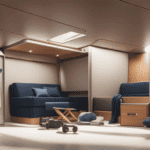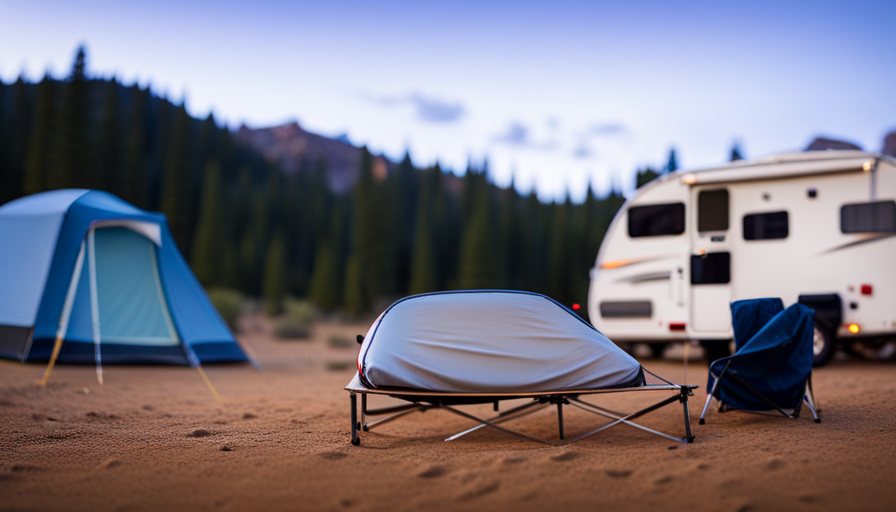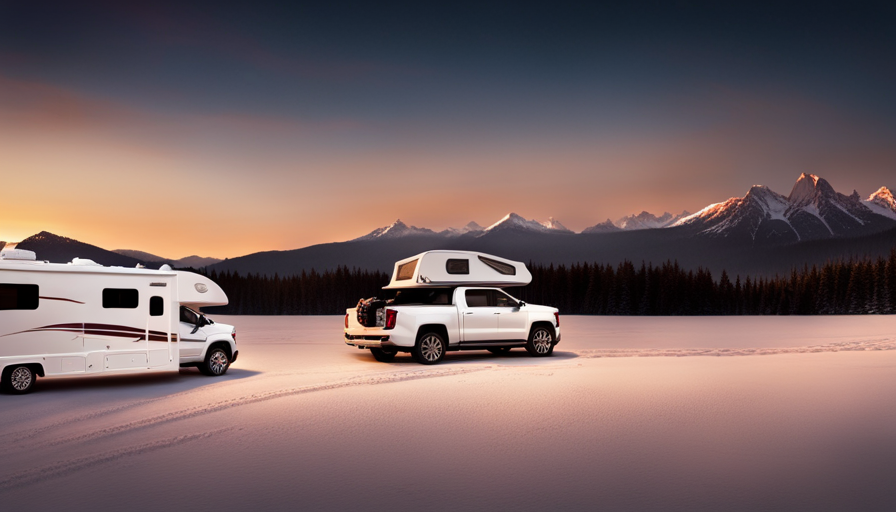You believe transforming a van into a camper is a simple task, correct? I must inform you that it is indeed challenging and not suited for those who easily give up. Converting a standard van into a comfortable and efficient mobile home requires considerable time, dedication, and expertise.
But if you’re up for the challenge, I’m here to guide you through the process.
In this article, I’ll show you step-by-step how to transform a plain old van into the camper van of your dreams. From choosing the right vehicle to personalizing and decorating the interior, we’ll cover all the essentials.
Whether you’re a seasoned DIY-er or a novice with a hammer, this guide will give you the knowledge and confidence to tackle this ambitious project.
So roll up your sleeves, grab your tool belt, and let’s get started on this epic adventure of building your very own camper van. Trust me, the end result will be worth every ounce of sweat and tears.
Get ready to hit the road in style and comfort!
Key Takeaways
- Choosing the right vehicle is crucial for a successful camper van conversion.
- Insulation and soundproofing materials are important for creating a comfortable living space.
- Storage solutions play a vital role in maximizing space and keeping things organized.
- Prioritizing energy efficiency with solar panels and LED lighting is essential for an efficient electrical system.
Research and Choose the Right Vehicle
To start your camper van journey, you’ll need to research and choose the perfect vehicle that suits your specific needs and desires. Choosing the right vehicle for a camper van conversion is crucial, as it will determine the size, layout, and functionality of your mobile home on wheels.
There are several factors to consider when selecting a vehicle. Firstly, think about your intended use for the camper van. Are you planning on long road trips, or will it be more for weekend getaways? This will help you determine the size and fuel efficiency you need.
Next, consider your budget and mechanical skills. Older vans might require more maintenance, while newer models can be more reliable but also pricier.
Another important factor is the interior space and layout. Think about how many people will be traveling with you and what amenities you want to include. Will you need a bathroom or a kitchenette? These considerations will help you narrow down your options.
Choosing the right vehicle for your camper van conversion requires careful consideration of factors such as usage, budget, and desired amenities. Once you have selected the perfect vehicle, the next step is to plan and design the interior layout.
Plan and Design the Interior Layout
Imagine yourself creating the perfect layout for your dream home on wheels, carefully considering every detail to ensure maximum comfort and functionality. When it comes to planning and designing the interior layout of your camper van, there are a few key factors to keep in mind.
One of the first decisions you’ll need to make is the interior color scheme. Whether you prefer a bright and vibrant color palette or a more neutral and calming tone, the colors you choose will set the overall ambiance of your mobile home.
Next, you’ll need to think about furniture arrangement. It’s important to optimize the use of space in your camper van, so consider the size and placement of each piece of furniture. Will you have a fixed bed or a convertible seating area? Will your kitchenette be compact or more spacious? Take into account your daily activities and prioritize functionality.
As you finalize your interior layout, remember that the goal is to create a comfortable and inviting space. With the right color scheme and furniture arrangement, you can transform your camper van into a cozy home on wheels.
Now that you have the perfect layout in mind, it’s time to move on to the next step: insulate and soundproof the van, ensuring a peaceful and comfortable living environment.
Insulate and Soundproof the Van
Now that you’ve planned out the perfect layout, it’s time to ensure a peaceful and comfortable living environment by insulating and soundproofing your mobile home. Soundproofing techniques and insulation materials play a crucial role in creating a serene atmosphere inside your camper van.
To effectively soundproof your van, consider using materials such as mass-loaded vinyl, acoustic foam panels, and soundproof curtains. These materials help absorb and reduce noise, making your living space more enjoyable. Additionally, sealing any gaps or cracks in the van’s structure can prevent sound from entering or escaping.
When it comes to insulation, there are various options available. Commonly used materials include polyurethane foam, fiberglass, and reflective insulation. These materials help regulate temperature, keeping your van warm in the winter and cool in the summer. They also provide a barrier against external noise and vibrations.
To emphasize the importance of insulation and soundproofing, here’s a comparison table:
| Soundproofing Techniques | Insulation Materials | Benefits |
|---|---|---|
| Mass-loaded vinyl | Polyurethane foam | Reduces noise transmission |
| Acoustic foam panels | Fiberglass | Regulates temperature |
| Soundproof curtains | Reflective insulation | Prevents sound leakage |
With your van now insulated and soundproofed, the next step is to install the flooring and wall panels, creating a cozy and inviting interior space.
Install Flooring and Wall Panels
After insulating and soundproofing, it’s time to get creative with the installation of flooring and wall panels, transforming your mobile home into a stylish and comfortable space.
Did you know that the average person spends about 90% of their time indoors?
Choosing the right materials for your camper van’s flooring and wall panels is crucial. For the flooring, consider options like vinyl, laminate, or hardwood. These materials are durable, easy to clean, and can withstand the wear and tear of life on the road.
When it comes to wall panels, you have a variety of choices such as plywood, fiberglass, or even reclaimed wood. Each material has its own unique aesthetic and practicality, so take your time to decide what suits your style and needs.
Tips for installation:
- Measure twice, cut once: Accurate measurements are essential to ensure a proper fit for your flooring and wall panels.
- Use adhesive: Applying adhesive to the back of your panels will help secure them in place and prevent any shifting during travel.
- Allow for expansion: When installing flooring, leave a small gap around the edges to allow for natural expansion and contraction.
With the flooring and wall panels in place, it’s time to move on to the next step: building and installing a bed platform.
Build and Install a Bed Platform
Once you’ve got your flooring and wall panels in place, it’s time to create a cozy and functional bed platform for a good night’s sleep on the road.
The first step is to gather the necessary bed platform materials. You’ll need a sturdy and lightweight material for the base, such as plywood or aluminum, as well as support beams and brackets to ensure stability.
Measure the dimensions of your van to determine the size of the bed platform. Make sure to allow for some extra space for movement and storage underneath.
Once you have all the materials and measurements ready, it’s time to start building. Begin by cutting the base material to the desired dimensions. Attach the support beams using the brackets, ensuring they are securely fastened. To make the bed platform more comfortable, consider adding a layer of foam or a mattress topper on top of the base.
After building the bed platform, you can transition into creating storage solutions. This will maximize the space in your camper van and keep everything organized. From installing shelves and drawers to utilizing under-bed storage, there are plenty of options to explore.
By combining a well-built bed platform with efficient storage solutions, you’ll have a comfortable and functional space to rest and relax during your travels.
Create Storage Solutions
To optimize your space and ensure everything is well-organized, you’ll want to explore various storage solutions for your cozy and functional bed platform. Maximizing space is crucial in a camper van, and having efficient storage options will make your life on the road much easier.
Here are four storage ideas to consider:
-
Under-bed storage: Utilize the space beneath your bed platform by adding drawers or bins. This is a great way to store clothing, shoes, and other essentials without taking up valuable floor space.
-
Overhead cabinets: Install cabinets above your bed platform to store items such as books, cooking supplies, and electronics. This will keep them easily accessible while keeping clutter off the countertops.
-
Wall-mounted organizers: Use wall space to hang organizers for smaller items like keys, utensils, and toiletries. This will free up counter space and keep everything within reach.
-
Hanging storage: Hang storage pockets or baskets from the ceiling or walls to store items like hats, gloves, and small tools. This creative solution maximizes vertical space and keeps items off the floor.
By incorporating these storage solutions, you can effectively organize your essentials and make the most of your camper van’s limited space.
Next, we’ll discuss how to install an electrical system and lighting to ensure a comfortable and well-lit living space.
Install Electrical System and Lighting
Now that we’ve created efficient storage solutions in our camper van, it’s time to focus on installing the electrical system and lighting.
This step is crucial for ensuring a comfortable and functional living space on the road. When it comes to the electrical system, it’s important to prioritize efficiency. This means using energy-efficient components and properly sizing the system to meet your power needs.
Consider installing solar panels on the roof of your van to harness the power of the sun and reduce reliance on traditional sources. Additionally, invest in a high-quality deep cycle battery to store and distribute the electricity.
As for lighting, thoughtful design and placement can greatly enhance the overall ambiance of your camper van. LED lights are a popular choice due to their low energy consumption and long lifespan. Install lights in key areas such as the kitchen, sleeping area, and workspace to ensure adequate illumination. Don’t forget to include dimmable options for creating a cozy atmosphere.
With the electrical system and lighting in place, we can now move on to the exciting task of designing and installing the kitchen and dining area. This is where we’ll be able to cook delicious meals and enjoy them in comfort.
Design and Install Kitchen and Dining Area
Creating a cozy and functional kitchen and dining area will transform your road trip experience into a culinary adventure filled with mouthwatering meals and cherished memories. When designing your camper van’s kitchen, consider the size and type of kitchen appliances you want to include. Compact options like mini-fridges, stovetops, and microwaves are essential for cooking on the go. Optimize the limited space by utilizing foldable or multipurpose kitchen items such as collapsible sinks and cutting boards. Installing overhead cabinets and shelves can provide ample storage for cookware, utensils, and food supplies.
To maximize functionality, create designated stations for cooking, food preparation, and dining. A fold-out dining table or a countertop extension can be a great addition, allowing you to enjoy meals comfortably. Consider adding a bench or booth seating with storage underneath to make the most of the available space. Incorporate practical features like easy-to-clean surfaces and secure storage for fragile items.
As you put the finishing touches on your kitchen and dining area, it’s time to transition to the next step of adding plumbing and bathroom facilities. With these essential amenities in place, your camper van will truly become a home away from home on your epic road trip.
Add Plumbing and Bathroom Facilities
Enhancing the functionality and comfort of my mobile dwelling is achieved by incorporating plumbing and bathroom facilities. The installation of plumbing in a camper van is a crucial step in creating a fully functional living space. It involves connecting a water supply system and installing pipes, faucets, and drains. To ensure efficient water usage, I plan the layout of the plumbing system carefully, considering the available space and the needs of my family.
Additionally, I install a water heater to provide hot water for showers and washing dishes. When it comes to bathroom design, I prioritize maximizing the available space. I opt for compact fixtures such as a small toilet and a shower stall. To save water, I choose a low-flow toilet and install a greywater system that recycles water from the sink and shower for non-potable uses. I also install a ventilation fan to control moisture and odors.
Storage solutions are essential in a small bathroom, so I incorporate shelves or cabinets to keep toiletries and towels organized. Moving forward, I’m excited to personalize and decorate my camper van. This next step allows me to transform the space into a cozy and inviting home on wheels.
Personalize and Decorate Your Camper Van
Transform your mobile dwelling into a cozy and inviting home on wheels by personalizing and decorating it to reflect your unique style and personality. When it comes to camper van decor ideas, the possibilities are endless. Here are some personalized camper van accessories that can help you create a space that feels like home:
-
Window coverings: Add curtains or blinds to give your camper van a touch of privacy and style. Opt for colors and patterns that complement your overall design theme.
-
Wall art: Hang some artwork or photographs on the walls to add a personal touch. You can also create a gallery wall with a mix of frames and prints that showcase your favorite memories.
-
Throw pillows and blankets: Comfort is key in a camper van, and adding soft pillows and cozy blankets can instantly make the space feel more inviting. Choose fabrics and patterns that match your aesthetic.
-
Plants: Bring some greenery into your camper van by adding potted plants. Not only do they add a pop of color, but they also help purify the air.
-
String lights: Create a warm and magical ambiance by hanging string lights inside your camper van. They can be placed along the walls, ceiling, or even around the windows.
By incorporating these personalized camper van accessories, you can make your mobile home on wheels a true reflection of your style and personality.
Frequently Asked Questions
What are the best materials to use for insulating a camper van?
When it comes to insulating a camper van, the best materials are like a secret weapon. You want something that keeps you cozy in cold weather and cool in the scorching heat.
My top picks for insulation are foam board, spray foam, and mineral wool. Foam board offers excellent thermal resistance, spray foam provides a seamless seal, and mineral wool is fantastic for soundproofing.
Each has its pros and cons, so it’s crucial to consider your specific needs before making a choice.
How do I determine the electrical needs of my camper van?
To determine the electrical needs of my camper van, I start by calculating the power requirements of the appliances and devices I plan to use. This includes considering their wattage and the duration of use.
I also take into account any additional power needs, such as charging electronics or running a fridge. To meet these needs, I may choose to install solar panels on the roof of my van, which can generate electricity to power my devices while on the go.
Can I install a shower in my camper van?
Yes, it’s possible to install a shower in your camper van. To start, consider the available space and decide on a shower type that suits your needs, such as a wet or dry shower. Installing solar panels can help provide the necessary power for running the water heater. When choosing a water heater, make sure to select one that’s compact and efficient for your camper van’s size.
What are some creative storage solutions for a small camper van?
Sure! When it comes to creative storage solutions for a small camper van, foldable furniture and hidden compartments are key. Foldable furniture, like collapsible tables and chairs, can provide extra space when not in use. Hidden compartments, such as under-bed storage or hidden drawers, maximize storage capacity without sacrificing valuable floor space. These solutions are great for organizing your belongings and making the most of your small camper van.
How can I make my camper van more energy-efficient?
To make my camper van more energy-efficient, I would harness the power of the sun through solar panels. These panels would provide a sustainable source of energy, reducing my reliance on traditional power sources.
Additionally, I would invest in efficient appliances, such as a low-energy refrigerator and LED lighting, to minimize my energy consumption. By incorporating these eco-friendly solutions, I can enjoy a more sustainable and cost-effective camping experience.
Conclusion
Building a camper van is a rewarding and exciting project that allows you to create your own personalized home on wheels. From researching and choosing the right vehicle to designing and installing the interior layout, every step is filled with creativity and adventure.
Just like a blank canvas waiting to be painted, a camper van offers endless possibilities. So, grab your tools and let your imagination run wild as you transform your van into a cozy and comfortable sanctuary, like a warm hug on a chilly winter day.


